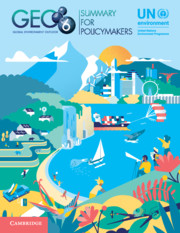2 - What is happening to our environment and how have we responded?
Published online by Cambridge University Press: 31 May 2019
Summary
Drivers of environmental change, megatrends and governance challenges
Human population dynamics or trends, particularly population pressure, and economic development have been acknowledged for many decades as the primary drivers of environmental change (well established). More recently, rapid urbanization and accelerating technological innovation have been additional influences. There are wide disparities globally in the consumption and production patterns that lie behind those drivers. ﹛2.1.1, 2.2﹜
Those driving forces are also strongly intertwined, complex, and spread widely and unevenly across the world(well established). They are megatrends, developing at speeds with which responses by established governance structures at all levels – urban and rural, local, national, regional, global and supranational – are thus far insufficient to keep pace. ﹛2.1.1﹜
The global population in 2018 is some 7.5 billion, with median projections estimating nearly 10 billion by 2050 and nearly 11 billion by 2100 (United Nations figures)(well established). Increases in life expectancy and reductions in infant and other mortality mean that population growth rates will continue to remain positive in all regions except Europe and certain parts of Asia. Unequal access to education, and lack of empowerment of women, as well as their lack of access to sexual and reproductive health services, all contribute to high birth rates. Without changes in production and consumption patterns, population growth will continue to increase environmental pressures. ﹛2.3, 2.3.4, 2.1.1﹜
Urbanization is happening at an unprecedented rate globally and cities have become the foremost drivers of economic development across the world(well established). More people, especially in emerging and developing economies, are living in cities and towns, and the world's urban population is expected to rise to 66 per cent by 2050 (well established). Approximately 90 per cent of city growth will occur in Africa and Asia. Africa is the most rapidly urbanizing region, and is also the region expected to experience the highest population growth (well established). Some 30 per cent of urban residents globally have no access to basic services or social protection, with poor women in low-income urban neighbourhoods being particularly vulnerable. ﹛2.4, 2.4.3﹜
Almost all coastal cities of any size and small island developing States are increasingly vulnerable to rising sea-levels, floods and storm surges caused by climate change and extreme weather events(established but incomplete).
- Type
- Chapter
- Information
- Publisher: Cambridge University PressPrint publication year: 2019
- Creative Commons
- This content is Open Access and distributed under the terms of the Creative Commons Attribution licence CC-BY-NC-ND 4.0 https://creativecommons.org/cclicenses/



